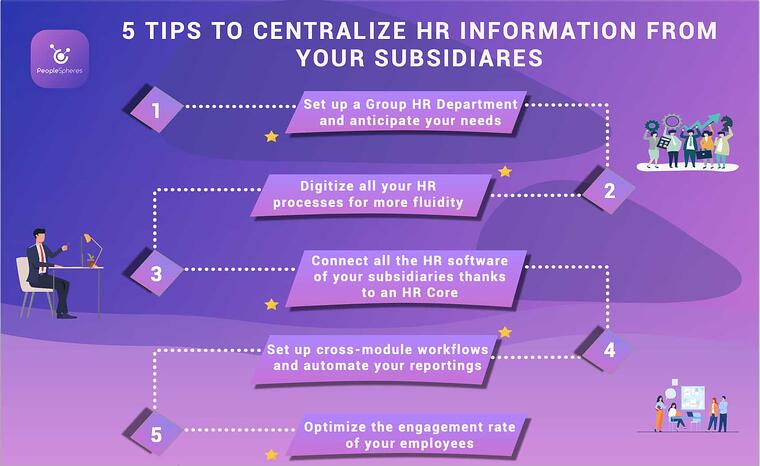
In the era of globalization, the number of transnational corporations (TNCs) increased sharply at the end of the 20th century, reaching 83,000 in 2010 (up from 7,000 in 1960). They now own more than 810,000 subsidiaries abroad and almost 80 million employees worldwide.
Many support functions have needed to centralize their data to obtain the necessary hindsight to keep their business running smoothly. For example, cash pooling, i.e., the centralization of financial flows, is a management practice that companies have adopted to manage their finances on a global level.
In terms of human resources management, globalization poses a major HR issue for the parent companies and their subsidiaries: how can we manage payroll when about fifty employees leave and arrive at the company every day? How could we maintain good management and keep everyone up to date with news from subsidiaries on the other side of the world to the neighboring regions?
To facilitate the management of human resources in companies with subsidiaries, the human resources department can set up an HRIS (Human Resources Information System), a strategic HR tool that will aggregate all data from employees… However, it is still necessary to choose your system carefully and to know how to implement it correctly.
Related articles:
What is Data Management? Your Guide to Excel in the Future of HR
Embracing HR Digital Transformation

Step 1: Set up a Group HR Department and anticipate your needs
Having global HR data management has several considerable advantages: in addition to providing great HR support with simplified talent management systems (mobility management at a general level, exchange of best practices between subsidiaries, accurate and improved reporting at group level…), you will also be able to have aggregated data on the administrative management in your different entities (recruitment time, salary levels, number and type of employee training, turnover at subsidiary and group level, number of employees in a given point in time, performance campaign completion rate, etc.)
Group HR department: anticipate needs
The first step in structuring your organization and centralizing your HR management will be to review your needs and resources in this area. Therefore, as a first valuable step, it will be necessary to involve all the human resources managers of your various subsidiaries in this process.
Here are a few questions you could ask them:
- What kind of problems do you encounter while managing your human resources at the local level?
- What are your expectations for centralized HR management?
- What data do you think is relevant to you regarding the success of the company?
Note that it is just as important to ask these types of questions to the parent company to raise more global issues for the overall group (data management for the entire group, standardization of processes, globalized talent management, compliance with GDPR, etc.)
Asking the right questions is, indeed, the best way to identify the problems your employees are encountering. Involving them in problem-solving is certainly motivational. Employees feel listened to and are pleased to know that their advice matters. Based on these answers, HR professionals will finally come up with concrete solutions that will solve real issues both locally and globally.
Take inventory of the available resources and tools used in your subsidiaries.
Before organizing your HR management and centralizing employee data from your subsidiaries, it is extremely important to understand how data is collected at a local level.
Do your subsidiaries already use different HR software (Leave and Absence, Payroll, Talent Management, Planning…)? Do they collect the same type of data?
A survey may be practical at this stage. Here are some potential questions to help you develop your surveys:
- What software do you use in your HR department?
- Which ones do you prefer and why?
- Which ones would you like to replace and why?
- What are the problematic tasks in your day-to-day?
- How can you make your day-to-day tasks easier?
- Which data and KPIs are essential to managing local HR management?
- And at the global level?
Set up relevant indicators
HR Indicators (KPIs: Key Performance Indicators) are essential for good management in your subsidiaries because they are the indicators that will allow you to analyze what is happening there and monitor changes over time. But you still need to know how to follow the right indicators: not all of them will be relevant metrics for your organization, which is why you will need to determine your needs and objectives.
Associated with a dashboard, your indicators will allow you to visualize the results of your daily efforts and tasks, monitor your projects over the long term, highlight your actions, make better decisions and convince your board of directors.
Here is a list of indicators you could track:
- Recruitment and communication KPIs (contact and response times, recruitment duration)retention rate…)
- Mobility and training KPIs
- Performance KPIs (by entity, by employee, by department)
- Employee engagement KPIs
For example, thanks to the indicators you set up, you will be able to precisely visualize the fluctuations of the number of employees at the group level: but the data still needs to be able to circulate in real-time…
This will be the subject of our next point. Without digitalizing your HR processes, it will be almost impossible to aggregate your subsidiaries’ data and avoid tedious data entry and processing errors. Moreover, digitalization is now an inevitable HR strategy that HR departments must consider. Digitalization leads to paperless and offers more agile human resources management.
Step 2: Digitalize all your HR processes for more fluidity
To centralize the data of your subsidiaries, you will need to switch to more fluid processes: information will have to be able to flow back and forth in real-time to avoid the risk of errors and optimize the performance of the various HR departments. Besides, dematerialization has significant advantages: saving time, money, empowering employees, and, above all, communicating information much more quickly and easily.
Avoid human error and time-consuming manual processing
Manually processing documents involves a significant risk of human error. The digitalization of your paperwork gives you a double advantage for the subsidiaries but also the parent companies: indeed, in addition to allowing you to visualize the information of your subsidiaries in real-time (attendance planning, organization charts, updated payroll, synchronized KPIs), it will facilitate the work of your various HR departments (automation of data transfers, limitation of data entry…).
Empower your employees
The digitalization of your HR services at the subsidiary level will also empower your employees: they will be able to take their steps directly online and follow their requests instantly via the portal. The digitalization eliminates the need for distributing physical documents, the mailing of payslips, etc. In addition to simplifying the life of the human resources manager, it also improves the daily life of employees. In fact, they can take their vacations and submit their expense claims by the minute, in a virtual space. All their documents are stored and archived: tracking is much easier!
That’s also why it’s crucial to gather your employees’ needs (both locally and globally) before implementing your employee experience platform. Show them the benefits of the HRIS project you are setting up and all the advantages this tool will bring them to their daily life. Change can be frightening, so you need to overcome reluctance, firstly by communicating clearly and precisely, but also involving as many employees as possible in the process. Such a collaborative platform will simplify interactions between team members, increase employee satisfaction and employee productivity.
If these software are connected to an HR Core just like the one at PeopleSpheres, employees can access all their tools via a unique HR portal; this limits the number of entries and is a real all-in-one tool for daily life in the company.
The HR Core tool is essential for this process. The HR Core will enable you to collect data and allow the information to circulate between the different entities of the group.
Step 3: Connect all the HR software of your subsidiaries thanks to an HR Core
External growth and the internationalization of companies have pushed the creators of HR software to implement the unification of employee data in a single software via a unified HR platform.
What is an HR Core?
The HR Core of a company is a system that centralizes all administrative and employee-related information such as talent management, legal information, compensation management, skills management, internal communication, etc. The HR Core has revolutionized the HR function and has led to great competency, particularly for companies with international operations.
Let’s take a concrete example: your company has five subsidiaries, abroad or in the same country. These subsidiaries, resulting from external growth, have their HR tools that have been in place for years. Concretely, they each have different software for leave & absence, talent management, and performance management.
To standardize the data and be able to organize the centralization of information, you have two solutions:
1st solution: uninstall everything to install the same suite of HR software throughout a single vendor at the parent company and subsidiary level.
Standardizing in this way can allow you to centralize all data easily since the data is homogeneous. However, be careful not to choose software just because it is part of a software suite.
Note that this solution implies change management which can last a few months or more. Additionally, you need to note that the installation of the software, its implementation as well as the training, contribute to a cost in time and money.
2nd solution: use your existing software. Enrich and centralize it.
Enhance the centralization of your HR functions by installing an HR core capable of reading and translating data from all your software in your various subsidiaries. In addition to being installed in a few weeks, this type of HR Core has the advantage of not disrupting the habits of your employees and therefore not slowing down the performance of your company. The HR core harmonizes and centralizes all the information provided by the different software of your subsidiaries to produce homogeneous and standardized data. Adding enterprise search lets HR quickly find data across subsidiaries without switching modules.
You will be able to take advantage of this opportunity to conduct an audit of the HR solutions utilized in the company to find out which ones have the best performance and possibly implement them where necessary in the company.
Besides, your employer brand remains in tact since the employee can access all their software via the core; therefore, they have a single login entry and a single HR portal for all their HR requests.
Finally, the HR Core also allows you to connect to other existing tools (ERP, CRM…) to cross-check data and obtain more in-depth reports, for example on employee performance.
Case Study: Consolidating 23 entities into one HR system
In the context of integrating and centralizing data in HR systems, CCCP13‘s case presents a compelling example. This association, responsible for managing the paid leave and benefits of professional dockworkers, faced significant challenges due to its structure. With 23 separate entities and a workforce comprising 1500 active and 3100 inactive staff, CCCP13’s HR processes were complex and fragmented.
To address these challenges, CCCP13 implemented a unified HR platform that connected all existing systems, which were already adapted to their organizational specifics. This strategic move centralized data into a single repository, simplifying management across multiple entities. Such centralization was crucial for CCCP13, allowing for more streamlined and efficient HR practices. This case study illustrates the transformative impact of integrating HR systems, especially in complex organizational environments like that of CCCP13.
What is the purpose of an HRIS?
The HR core allows you to go even further in your research. An HR team will be able to search on parameters that correspond to their location. This will be of particular interest to companies with an international engagement since contracts, documents will automatically be brought into compliance with the laws of the country.
Thus, connecting the various software in your subsidiaries into an HR core will enable you to set up a global HRIS with minimum effort for implementation and change management. In just a few weeks, you will be able to take full advantage of the tool in all your subsidiaries and collect the data necessary for your reporting.
It is necessary to set up adapted workflows and automate data updates in order to optimize these reports. This will be the subject of our next point.
Step 4: Set up cross-module workflows and automate your reporting
Automate processes with workflows
A workflow represents a set of tasks that allow a defined operation to execute.
For example, a workflow approval of a leave request will involve the following steps:
- The employee sends a leave request via his HR Core (notification is sent to the manager to approve or refuse the demand).
- The manager accepts or refuses his request (notification is sent to the employee)
- Schedules are updated
- Attendance data is updated in the various dashboards.
Sounds simple, right? Let’s take a look at another example of workflow. This time it will be cross software. This is possible when you have an HR platform that allows you to synchronize all your software.
Event: A new employee joins the company
- A new employee is entered as an employee in the HR Core.
- The information is automatically synchronized in the company’s other software programs.
Typically, the human resources department has to enter the new employee’s personal information into the various software (leave, payroll, planning, performance management, etc.) Thanks to the HR Core, the information is automatically entered into the various HR modules without the need for additional data entry.
Another type of cross-software workflow:
Event: This new collaborator has a trial period of 4 months.
- The HR department informs the duration of the trial period of the new employee,
- 1 month before the end of the trial period, a notification is triggered on the Manager’s portal reminding him that a performance review is to be scheduled.
Last example:
Event: an employee leaves the company
- A notification is sent to the CIO to terminate the different accesses of the employee,
- Depending on the country where he worked, the data is stored or deleted from the various software programs in accordance with the legislation
- At the end of the legal period, his data is automatically deleted
Why are workflows important in an HR context?
Workflows are essential in an HR context to facilitate and automate tasks that are repetitive, time-consuming and have little added value for your HR departments.
The HRIS tool will automate all repeated administrative tasks via the workflow. You will only need to set up the workflow once. Consequently, whenever needed, the process will start automatically.
Workflows will be useful for implementing cross-functional processes, sharing and comparing HR KPIs (proportion of new employees, time to hire, retention rate, etc.). This will enable you to better understand your subsidiaries’ issues, assess their needs, and allocate the necessary resources to them.
Create a customized dashboard
To better centralize data from subsidiaries, create dashboards that allow you to view data instantly. Creating relevant KPIs (step 2) is extremely important to build your HR dashboards efficiently.
Your centralization tool becomes a real HR database where all the information of all your employees is available. You locate the data you need and compile them to analyze and follow their progress. Thanks to a multi-software HRIS, you will be able to compile and compare the data of your subsidiaries with each other. Moreover, it will provide a global view of the information of the whole company. HR dashboards with an HRIS are much more dynamic and customizable, enabling HR executives, managers, and employees to set common or individual goals. For example, HR executives can better manage human capital, look over at financial indicators, verifying the efficiency of recruiting campaigns, training programs, and much more.
Select a tool that will allow you to both create a dashboard and export your data and graphs. Such a tool will be equipped to export your reports and help you make the best decisions.
Step 5: Optimize the engagement rate of your employees
Combine the useful with the pleasant by making your information centralization tool an intuitive and ergonomic platform for your employees. You will thus promote the interconnection between employees and the development of your employer brand.
The implementation of an HR core, in particular via HRIS software such as the one PeopleSpheres offers, enables employees to feel part of the company. They are no longer simply part of an office, a subsidiary, etc., but of a single, entire entity. This promotes employee commitment to the company and therefore increases the company’s employer brand.
- To inform your employees by pushing them the information they are interested in,
- To organize events on a global as well as local scale and give your employees the opportunity to give you their opinion via surveys.
Another tip: continuously improve your processes to make users want to enter their information in a simple way via a single HR core. You will thus optimize the engagement rate of your employees worldwide and have coherent communication to build a strong employer brand.
Step 6: Don’t forget data security
Centralizing your subsidiaries’ HR data via an adapted database should now seem indispensable to you. However, be careful which HR core you choose! In terms of security, handling HR data is extremely sensitive.
Here are two points to ensure that your tool meets all safety requirements:
Data integrity and deletion
To comply with the different legislations regarding personal data, you need a tool that processes data under the different legislations of the countries in which you are present.
For example, the PeopleSpheres HR Core is GDPR compliant, allowing for data deletion which works via an automated workflow. If you set it up, it is possible to ensure that when a person leaves the company, their data is automatically erased from your databases after a certain period (which you also choose, depending on the laws of the countries in which you are present).
All identified data is deleted but you keep the history of the fields that do not allow the identification of the owner of this data for your reports.
Storage and archiving security
To store and file your data securely, we advise you to set up a digital safe linked to your base in your company and subsidiaries. Thanks to this tool, you can digitally store all your documents and simplify your document exchanges in complete security. You will be able to centralize your data in a single, easy-to-access digital safe.
At the heart of your strategy for better data centralization and efficient reporting, the HR Core is necessary when it comes to centralizing dispersed data across the different entities of a company. HR core is the solution for many HR issues and undoubtedly improves work life. Having the possibility to centralize the data from the parent company as well as its subsidiaries will create better alignment with the overall objectives of the company. Plus, personnel management will take on a whole new meaning. Employees will be more aware of what is happening and communicate better with each other.
To get an overview and centralize the data of your subsidiaries, here are 5 (+1) things that your company should consider when centralizing your HR functions:
- Set up a Group HR department
- Digitalize your HR processes to make for seamless procedures.
- Connect all the HR software from your subsidiaries thanks to an HR core.
- Set up cross-application workflows and automate your reports
- Optimize your employee engagement rate
- And finally, don’t forget about the security of your data
 Alexandre Diard
Alexandre Diard
Alexandre Diard is an accomplished Chief Marketing Officer with a genuine entrepreneurial spirit. His unwavering passion for innovation and technology is evident through his impressive track record. Boasting over a decade of hands-on experience in the HR industry, Alex has consistently delivered groundbreaking solutions to HR leaders worldwide. From transforming HR automation to revolutionizing data management and workflow optimization, his unparalleled expertise spans the entire spectrum of HR technology.


 Alexandre Diard
Alexandre Diard-360x360.jpg)

-640x380.jpg)
